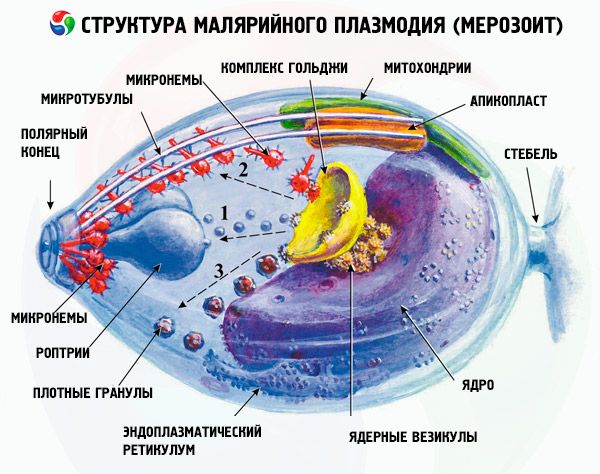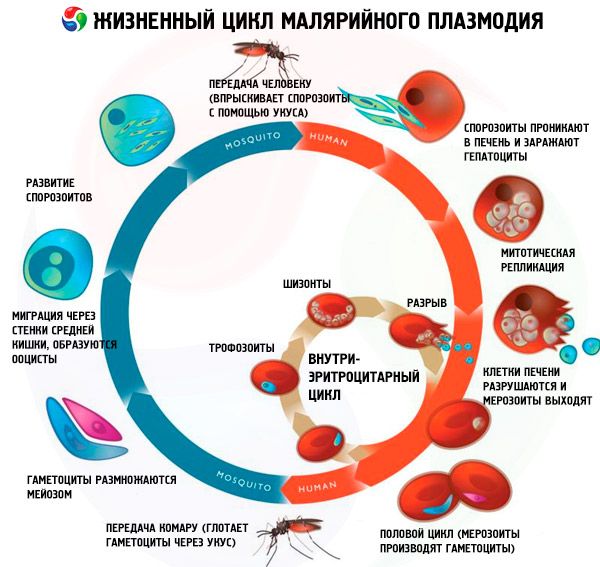Medical expert of the article
New publications
Malaria plasmodium: stages, species, development scheme
Last reviewed: 06.07.2025

All iLive content is medically reviewed or fact checked to ensure as much factual accuracy as possible.
We have strict sourcing guidelines and only link to reputable media sites, academic research institutions and, whenever possible, medically peer reviewed studies. Note that the numbers in parentheses ([1], [2], etc.) are clickable links to these studies.
If you feel that any of our content is inaccurate, out-of-date, or otherwise questionable, please select it and press Ctrl + Enter.
The malarial plasmodium causes such a dangerous protozoan disease in humans, which is chronic and recurrent, as malaria, from which, according to the World Health Organization, almost 2 million people die every year worldwide.
And today, the leading infectious disease causing death is not AIDS, but malaria.
Structure of malarial plasmodium
The only way the malaria plasmodium enters the human body is through a mosquito bite. And of the more than three thousand species of these dipterous insects that exist in nature, this parasite is carried only by the malaria mosquito of the genus Anopheles (Anopheles superpictus). Moreover, this mosquito must be a female, since it is she who needs blood as a source of proteins for hatching eggs.
At the moment of the bite, the mosquito injects saliva into the human skin (to prevent the blood from clotting), and along with the saliva, sporozoites of the malarial plasmodium enter the skin. The sporozoite is the reproductive form of only one stage of the life cycle of this protist. The structure of the malarial plasmodium at the sporozoite stage has the appearance of oblong and slightly curved cells no more than 15 microns in size.
The main host of the malaria plasmodium is the anopheles mosquito, since in its body the plasmodium performs sporogony (sexual reproduction). And man is an intermediate host of the malaria plasmodium, since it uses the Homo sapiens organism for agamogenesis, that is, asexual reproduction. Biologists have found that in single-celled organisms of the genus Plasmodium, asexual reproduction has a special form of schizogony, when the original cell divides not into two daughter cells, but into many at once. Thus, the reproduction of the malaria plasmodium is adapted to the method of its spread - from one host to another.

Life cycle of malarial plasmodium
The malarial plasmodium belongs to the simplest microorganisms of the kingdom Protista, class Sporozoa, order Haemosporidia, genus Plasmodium.
The malaria plasmodia species Plasmodium vivax, Plasmodium malariae, Plasmodium falciparum and Plasmodium ovale are dangerous to humans because they cause malaria. The malaria plasmodia species Plasmodium ovale is rarer and can only be contracted in the African or Asian tropics.
The life cycle of the malarial plasmodium: from mosquito to human
The development cycle of the malarial plasmodium is divided into two practically equal parts, each of which takes place in the body of either a mosquito or a human. Let's start from the moment when the sporozoites of the malarial plasmodium penetrate the human body.
Once in the blood, the sporozoite very quickly ends up in the liver tissue and here they begin asexual reproduction (schizogony), turning into merozoites. These hungry young plasmodia penetrate the red blood cells (erythrocytes) and, absorbing hemoglobin, continue to reproduce vigorously in the same asexual way. At this stage, the structure of the malarial plasmodium is cells no more than 2 microns in size with protoplasm and a nucleus, their shape is round or oval (similar to an amoeba).
Then the merozoites, destroying the erythrocytes, exit them and take the form of rings, and in their protoplasm cavities are formed - digestive vacuoles, which accumulate nutrients and remove waste products: this is how plasmodium toxins enter the human bloodstream.
At this stage, the development of the malarial plasmodium occurs “on schedule” - every 48 hours, and just with the same frequency, a person infected with malaria begins to have bouts of fever with chills and a very high temperature.
Erythrocyte schizogony is repeated cyclically and continues until the number of merozoites reaches the required level. Then the development cycle of the malarial plasmodium enters the next stage, and gametocytes are formed.
The life cycle of the malarial plasmodium: from human to mosquito
In order for the malaria plasmodium to begin sexual reproduction (sporogony), it must change hosts and enter the stomach of an anopheles mosquito. By this time, the gametocytes are ready to divide into microgametocytes and macrogametocytes.
And as soon as a mosquito bites a person sick with malaria, the gametocytes "move" to their main host with the sucked blood. Here, microgametocytes turn into male reproductive cells of plasmodium, and macrogametocytes - into female ones. Each type of these reproductive cells has a single (haploid) chromosome set. What happens next is easy to guess, and as a result of the fusion of gametes of the opposite sex, diploid cells with a full set of chromosomes are obtained - zygotes of malarial plasmodium, which have an elongated shape.

The zygotes of the malarial plasmodium are very mobile and, without delay, get stuck between the cells of the muscular wall of the insect's stomach, attach themselves there and form sporocysts - round incubator cells covered with a shell (created, by the way, from mosquito tissue). This cycle of development of the malarial plasmodium in the mosquito's body is one of the last. During the growth of sporocysts, cellular mitosis continues under their shell, and hundreds of sporozoites (the structure of which was described above) are formed in each.
There comes a moment when the shell ruptures, and all these sporozoites are simply inside the body of the insect. They just have to get closer to the "exit", and the mobile sporozoites cope with this task well, penetrating into the right place - the salivary glands of the anopheles mosquito.
Blood for malarial plasmodium
Blood for malaria plasmodium is taken from a finger on the hand in the usual way, and then a blood smear is made on a sterile glass slide, which is examined under a microscope.
Since the types of malarial plasmodia differ somewhat from each other in their structure, each type has clear diagnostic features.
Experts include the structure of the malarial plasmodium and the nature of the changes in the affected erythrocytes among such signs. As a rule, such red blood cells are enlarged, some change their shape and color, etc.
Prevention of malarial plasmodia
To this day, no one has succeeded in creating a vaccine against malaria, which is why prevention of malaria plasmodia is so important.
In areas of the world where malaria is endemic, prevention of malarial plasmodia is primarily aimed at destroying Anopheles mosquitoes using insecticides.
For personal protection against bites of malarial mosquitoes, various repellents are used (liquid, creams and aerosols), closed clothing and mosquito nets are worn, which are also sprayed with repellents.
There are special pharmaceutical preparations for the prevention of malaria plasmodia. When going to places where malaria is common and there is a risk of catching it, these drugs should be taken in advance.
For example, the antimalarial drug Delagil (Chloroquine, Resoquine) in tablets is taken 0.5 g twice a week, and then 0.5 g once a week. The action of the drug is based on the ability of its active substance - a derivative of 4-aminoquinoline - to inhibit the synthesis of nucleic acids and thereby destroy the cells of the malarial plasmodium. This drug is contraindicated in cases of kidney and liver dysfunction, severe heart failure, and decreased hematopoietic function of the bone marrow. It should also not be taken by pregnant women and preschool children. Doctors note that after leaving a malarial area, the drug should be continued for at least another month.
Who knows what else Alexander the Great would have conquered and what Oliver Cromwell would have done for England if they had not been bitten by a malarial mosquito and the malarial plasmodium had not caused a fatal disease.


 [
[